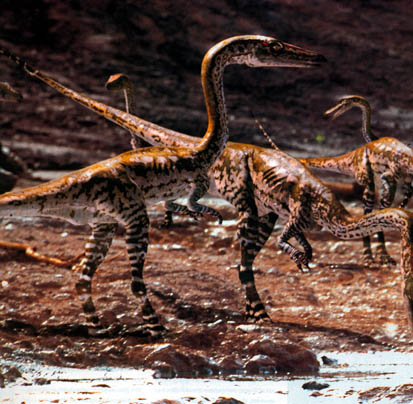
The basal neotheropod Coelophysis bauri, latest Triassic of central western Pangea.
From Rare Resource - Dinosaur Gallery
| Theropoda | ||
| The Vertebrates | Neotheropoda |
| Vertebrates Home | Vertebrate | Vertebrate |
|
Abbreviated Dendrogram
Dinosauria
├─Ornithischia
└─┬─Sauropodomorpha
│
└─Theropoda
├─Herrerasauridae
├─Eoraptor
└─Neotheropoda
├─Podokesaurinae
│ ├─Coelophysis kayentakatae
│ └─┬─Coelophysis bauri
│ └─Coelophysis rhodesiensis
├─Segisaurus
├─Liliensternus
└─┬─Zupaysaurus
└─┬─Dilophosaurus
└─Averostra
├─Ceratosauria
└─Tetanurae
└─Avetheropoda
├─Carnosauria
╘═Coelurosauria
└─Aves
|
Contents
Index |
 The basal neotheropod Coelophysis bauri, latest Triassic of central western Pangea. From Rare Resource - Dinosaur Gallery |
The clade Neotheropoda was first coined by Bob Bakker (1986), and further defined by Sereno, 1998 and Nesbitt 2011. Basically this group includes all theropods other than a few very early primnitive ones, and also other than the Herrerasaurs (which are so close to the ancestral stem of dinosaurs that they may or may not even be theropods; alternatively, proto-theropods might be considered the original line from which all other dinosaur types evolved). Coelophysids, dilophosaurs, ceratosaurs, allosaurs, tetanurines, allosaurs, coelurosaurs, tyrannosaurs, maniraptors, and birds, are all, technica;lly speaking, neotheropods. Indeed, such is the taxonomic uncertainty around the stem of the dinosaur family tree that the demarcation between neotheropods and theropods may not be clear. However, we have followed Nesbitt 2011 in recognising the Neotheropoda as the clade including Coelophysis, modern birds, their common ancestor, and all its descendents. In other words, all theropods above the herrerasaur, Eodromaeus, Eoraptor, Daemonosaurus, and Tawa grade. Admittedly it seems pretty silly to refer to 99.999% of theropods and about 95% of their evolutionary history as "-neo" (new), but cladistic nomenclature often comes up with irritating jargon (e.g. Pseudosuchia (false crocodiles) a sthe calde that includes true crocodiles), and rather than use little known alternatives like Eutheropoda or the splendidly appropriate but unfortunately junior synonym Avepoda ("bird feet") (Paul 2002, Paul 2010), we have decided the easiest course of action is just to go with the consensus.
As Justin Tweet (Thescelosaurus website) puts it "the main difference between Theropoda and Neotheropoda is that neotheropods show the first big digital reduction: they have lost the fifth finger entirely, shrunk the fourth finger and metacarpal (if present) to very little or do away with it altogether, and the feet show only three truly functional digits, the fifth reduced to a splint of metatarsal and the first drawn high up the metatarsals." The result in other words was the bird-like three-toed foot, hence Greg Paul's very descriptive term. Very likely there were other differences as well, including soft-body physiology, metabolic and ecological ones, since the neotheropods survived the end-Triassic extinction event, whereas the ancestral theropods didn't, (a more dramatic analogy can be made with neornithes surviing the K-T extinction relatively unscathed
The earliest and most primitive of the neotheropods are a broad assemblage referred to as ceratosaurs. Ceratosaurs were one of the first clades (as opposed to linnaean ranks) of dinosaurs to be named (Gauthier 1984), along with its sister taxon the Tetanurae (Gauthier 1986). They often feature unusual crests on their head, perhaps a device for intraspecific rivalry or mating. They seem to have become extinct during the end Jurassic in Laurasia, although if abelisaurs are Ceratosaurs (and this is generally stated but still not certain), than these animals survived in Gondwanaland right up to the end of the age of dinosaurs.
Only a decade or two ago the Ceratosauria were accepted in mainstream dinosaurology to be a monophyletic group (e.g. Rowe & Gauthier 1990). A 1994 analysis by Holtz follows Gauthier in having the coelophysoids and neoceratosaurs forming a clade (Ceratosauria), and together forming the outgroup to Tetanurae. Very soon though, cracks began to appear, and it was suggested that these two taxa may not form a clade exclusive of other known theropods (e.g. Rauhut 2000). There are also some derived features found in neoceratosaurs (Ceratosaurus and Abelisaurs) which are not found in coelophysoids. This would be evidence that neoceratosaurs are closer to tetanurines than to coelophysoids. In this case, the neoceratosaur/coelophysoid characters would have to be convergences and/or primitive neotheropod features lost in Tetanurae, and the Ceratosauria are paraphyletic or even polyphyletic.
It is now looking increasingly likely that all the Ceratosauria as originally defined, and for that matter its included subclade Coelophysoidea (which includes the (families Podokesauridae (better known as Coelophysidae) and Dilophosauridae), are a series of smaller clades (Yates 2006, Smith et al 2007), or even a paraphyletic assemblage or an evolutionary grade, rather than monolithic clade (Nesbitt et al 2009, Nesbitt 2011). This also makes sense from a stratigraphic context, as otherwise we are burdened with innumerable ghost lineages and non-existent ancestors, when the ancestors (or at least their close cousins) and transitional foms were before us all the time.
On the other hand, the monophyletic status of the Tetanurae has never been challenged, so we can confident that birds and various higher theropods (Allosaurus, Velociraptor, T. rex, and other less famous representatives) all share a single common ancestor. Moreover, a more restricted Ceratosauria, including both the Jurassic Ceratosaurus and the Cretaceous Gondwanan Abelisaurs, and equivalent to the old Neoceratosauria, likewise constitute a natural group (e.g. Carrano & Sampson 2008). Both of these groups are described in the following pages. The present page however is concerned with the earliest and most primitive of the neotheropods, a broad assemblage of light-built carnivores that in the past were included under the postulated clades Coelophysoidea and Ceratosauria, and the family Podokesauridae. MAK011128 updated 120206
The following dendrogram shows early neotheropod relationships; based on Ezcurra & Cuny 2007 and Smith et al 2007
When this basic phylogeny is plotted against time, the result is as follows:
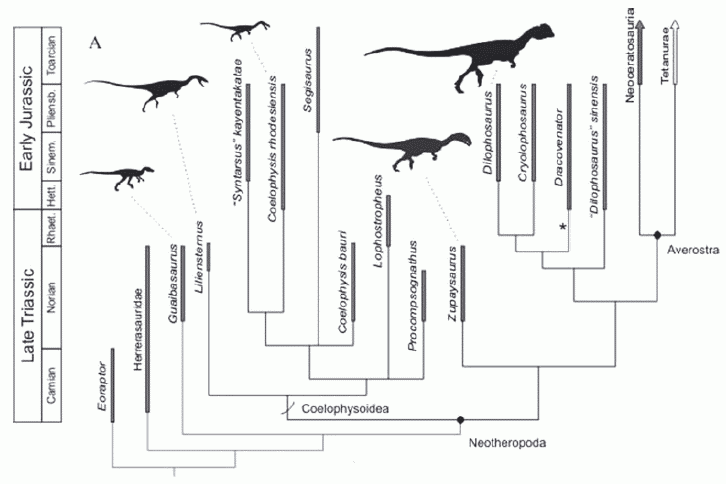 Time calibrated phylogenetic relationships of basal theropods. "Coelophysoids" are here shown to be a paraphyletic group. The asterisk indicates an alternative placement of Zupaysaurus as sister taxon to Dracovenator, according to Yates (2005); dotted lines indicate uncertain position of herrerasaurids and Eoraptor according to Sereno (1999) and Guaibasaurus according to Langer & Benton (2006). Diagram and caption from Langer et al 2010 fig 17. |
A similar but low resolution cladogram is provided by Xu et al 2009; the following is adapted from a larger cladogram (fig S4 uin the supplementary material), names for supra-generic taxa are added for the sake of comparison
The above phylogenies all assume a monophyletic Coelophysoidea (Coelophysidae + Liliensternus) within a paraphyletic Coelophysoidea (sensu Gauthier). A different picture is presented in Nesbitt et al 2009's (and following them Sues et al 2011)'s cladogram for example has Liliensternus more derived than Coelophysis, and Zupaysaurus more derived than Liliensternus, giving the following: Coelophysis (Liliensternus (Zupaysaurus (Cryolophosaurus (Dilophosaurus (Averostra)))). Or in dendrogram form
Rather than being a basal taxon, Liliensternus is now intermediate between the small Coelophysis and the transitional Rhaetian taxon Zupaysaurus. In this pectinate arrangement these early theropods also form a general evolutionary gradation that broadly fits with the stratigraphy (the dilophosaurs come after the earlier Coelophysines, Procompsognathus etc) and the clades Coelophys-inae/idae/oidea collapse into a small cluster of species around Coelophysis. The following "low resolution" phylogeny is from Tom Holtz who in turn has incorporated a number of sources
Regardless of the specific phylogeny, the general agreement is that in terms of theropod "evolutionary pulses", there are first the Herrerasaurs and co, then the Triassic and Early Jurassic coelophysids, then the larger types such as Dilophosaurus and Cryolophosaurus in the early Jurassic (Zupaysaurus being transitional here both morphologically and straigraphically), and finally the higher (Ceratosauria and Tetanurae) theropods that first appear in the middle Jurassic, representing highly successful types that continue to the end of the Mesozoic (and in the case Tetanurae, evolve into birds). MAK120217
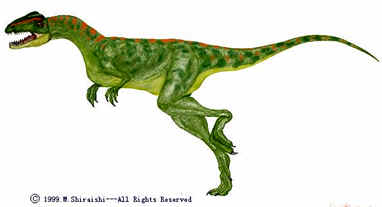 Neotheropoda:(=Coelophysoidea?): Coelophysis, Dilophosaurus, and more derived theropods. Pigeons > Prototheropods.
Neotheropoda:(=Coelophysoidea?): Coelophysis, Dilophosaurus, and more derived theropods. Pigeons > Prototheropods.
Definition: Coelophysis, Neornithes, their most recent common ancestor and all descendants (Sereno, 1998). The least inclusive clade containing Coelophysis bauri (sensu Colbert et al., 1992), and Passer domesticus (Nesbitt 2011.)
Synonyms: Avepoda, Eutheropoda
Range: Late Triassic to Late Cretaceous.
Phylogeny: Theropoda ::: Tawa + * : Podokesauridae + Liliensternus + (Zupaysaurus + (Dilophosaurus + ((Neo)Ceratosauria + Tetanurae))).
Characters: clavicles are fused into a single mid-line bone (furcula or "wishbone") that functioned as a spring/shock absorber, perhaps to deal with stresses on the forelimbs and shoulders from struggling prey. (It is not known whether or not Tawa, Eodromaeus, and even the herrerasaurs had furculae.); Manual digit V lost (so only four fingers or fewer); Five or more sacral vertebrae; Increased pelvic muscles, revealed by increase in size of attachment surfaces on ilium; Pedal digits I and V reduced (making the foot functionally tridactyl ("three toed"): metatarsal V lacks a toe, while metatarsal I is reduced with a small digit I (Tom Holtz).
Image: Liliensternus liliensterni, artwork © M. Shiraishi, reproduced with permission
Links: (the following is for Ceratosauria - these links haven't been checked and in any case need to be sorted taxonimically updating MAKDinoData: Ceratosauria; DinoData: Coelophysis; Coelophysis; Staab Studios - Coelophysis Model; The Fernleaf: Karen Carr; Ceratosaurian Theropods; Ceratosauria (Mikko's Phylogeny); Ceratosauria Dutch -- brief introduction & chart); A BASAL ABELISauria NOVAS, 1992 (Theropoda- CERATOSauria) FROM ... full text paper on relationships); Megalosaurus = Torvosaurus in Europe and following); ceratosauria.html Justin Tweet); Dinosaurier Interesse.de - Stanley- Ceratosaurier German); GEOL 104 Lecture 22- Theropoda I- Dinosaurs red in tooth and claw lecture notes from Tom Holtz); Ceratosauria. ATW030313.
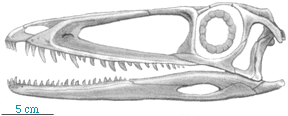 Drawing of Coelophysis skull courtesy of Professor Paul Olsen |
Podokesauridae von Huene 1914 : Coelophysis, Segisaurus
Definition: As originally defined, Podokesauridae was an evolutionary Linnaean taxon (and can still be used in that context). Sereno proposes a number of nested clades here, using Coelophysidae rather than Podokesauridae (see also comments section for reason for name changes), as follows: Coelophysoidea: The most inclusive clade containing Coelophysis bauri (Cope 1889) but not Carnotaurus sastrei Bonaparte 1985, Ceratosaurus nasicornis Marsh 1884, or Passer domesticus (Linnaeus 1758). taxon search. Coelophysidae: The least inclusive clade containing Coelophysis bauri and Procompsognathus triassicus Fraas 1913. taxon search. Coelophysinae: The most inclusive clade containing Coelophysis bauri but not Procompsognathus triassicus. taxon search. Unfortunately Procompsognathus is not a good choice of anchor taxon; it is a poorly preserved form that, depending on who you ask, might be a chimera (in this case a sphenosuchian skull and podokesaur skeleton), a non-Dinosaurian ornithodiran, or an unspecified ceolophysid (Wikipedia, see elso refs cited there), so the last two definitions are not of much use. Segisaurus halli Camp, 1936 may be a better choicxe, but even there the skull is missing, so detreming the precise relationship is difficult. How many species are included in the stem-based definition of Coelophysoidea depends on whether this assemblage of early theropods turns out to be a monophyletic or a paraphyletic group.
Synonyms and included taxa: Coelophysidae, Coelophysinae, Coelophysoidea, Halticosauridae, Procompsognathidae, Segisauridae
Range: Middle Norian to Early Jurassic
Phylogeny: Neotheropoda : Liliensternus + (Zupaysaurus + (Dilophosaurus + Averostra)) + * (paraphyletic?) : Coelophysis arizonensis + Coelophysis bauri + Coelophysis kayentakatae + Coelophysis rhodesiensis + Segisaurus (see Podokesaur phylogeny for various hypotheses)
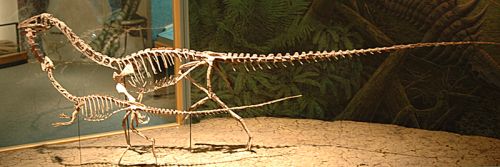 Coelophysis bauri, Denver Museum of Nature and Science. Photo by Firsfron, Wikipedia Creative Commons Attribution |
Characters: The following are characteristics of the "Ceratosauria": Maxilla & premaxilla weakly attached; large tooth from lower jaw fits into marked diastema; no maxillary fenestrae; $ 2 pairs of pleurocoels in cervical vertebrae; $ fusion of sacral vertebrae & ribs (adults); retain 4 digits in hand; $ 2 fenestrae in pubic plate; $ flange at distal end of fibula overlaps ascending process of astragalus anteriorly. ATW (no date).
Comments: Coelophysoidea was known as Podokesauridae until as recently as Carroll 1988. Paul 1988 points out that the original fossil remains of Podokesaurus, whose phylogenetic status was debatable to begin with, was lost in a fire, and all that remain are some poor quality casts. On those grounds he proposed renaming the taxon to reflect the better known Coelophysis. Holtz (1994) and Sereno (1998) formalised the terminology (although the family rank taxon Coelophysidae apparently goes back to Nopcsa 1928. Unfortunately, Baron von Nopsca was only familiar with Cope's Coelophysis, which was a Silesaur proto-dinosaur, and not Colbert's small Ghost Ranch theropod, which was a totally different animal, despite being assigned to the same genus. What's more, there is no requirement for the type species or type genus of supra-specific taxa to be based on good material for it to be valid - consider Phytosauridae for example! We have therefore followed Olshevsky 1991 in restoring von Huene's original taxon name (Matthew Martyniuk has also recently argued in favour of restoring Podokesauridae). Actually this is in keeping with a general trend in dinosaurology, in which over the past two decades or so taxa based on poor material are first renamed and then have their original moniker restored. So Megalosauridae changed into Torvosauridae and even Spinosauroidea before becoming once again Megalosaur-idae/oidea, and Titanosauridae spent several years as Saltosauridae before again returning to Titanosauridae. Hence Podokesauridae is used here in preference to Coelophys-idae/oidea.
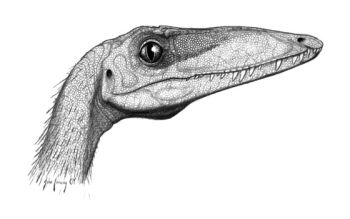 Life reconstruction of Coelophysis bauri, by John Conway. copied from Wikipedia, GNU Free Documentation / Creative Commons Attribution Share Alike |
The Podokesaurs are the most primitive of the neotheropods, and this linnaean/evolutionary taxon is certainly paraphyletic (i.e. it is the ancestral grade of all higher theropods - if one were to draw a romerogram it would be the bubble at the bottom from which the bubbles or balloons derive. Greg Paul divided these early theropod dinosaurs into two groups, the smaller Coelophysines and the larger Halticosaurines (the Dilophosaurs). (Paul 1988). A recent cladistic analysis reveals that the Halticosaurines are an artificial grouping, with some (Liliensternus and Lophostropheus) more primitive than both the smaller coelophysines and the Jurassic dilophosaurs (Smith et al 2007). A revision of Triassic stratigraphy by S. G. Lucas (1998) shows Coelophysis bauri to be late Norian or Rhaetic (latest Triassic) in age, rather than late Carnian as originally stated, so that it lived after both the large Liliensternus and small Procompsognathus. Of course, it may be that large size was a primitive feature of the neotheropods, with Coelophysis and co as later minaturised forms which continued through to the early Jurassic.
Although the position of Liliensternus is uncertain, current phylogenetic analyses agree on a monophyletic Coelophysoidea (sensu Sereno), even if they disagree on details. Because -oidea is the suffix for superfamily, and this does not seem to be a very diverse group, we have taken the liberty of replacing this with a subfamily ranking of Podokesaurinae (although Cladistics is rank free, in this way the name can do double duty as a linnaean taxon). Podokesaurinae is here considered to include a number of species, all of which can be placed in the genus Coelophysis (the present writer (MAK) rejects the move to monospecific genera, as this results in a disjunction between paleoherpetology and the rest of biological nomenclature (botany, zoology, invertebrate paleontology e.g. brachiopods, molluscs, trilobites, etc)).
There seems to be little agreement regarding the phylogenetic details here.
So for example Carrano et al 2005 give the following (below left) whereas Ezcurra & Cuny 2007 (amended in Ezcurra & Brusatte 2011, adding C. arizonensis) offer the cladogram on the right
The podokesaurs seem to have radiated quickly during the Norian and Rhaetian. The smaller forms - represented by the genus Coelophysis - survived into the Early Jurassic, where they flourished as small/medium-sized carnivores. Throughout the early Jurassic, Coelophysids and Dilophosaurids existed alongside each other for some 20 million years or so, indicating that these animals were very successful in their environment. Both large and small species show a tendency for head ornamentation in the form of crests, almost certainly for intraspecific display. The of all these large and small forms seem to have developed independently in different lineages, rather than all podokesaurs being descended from a single crested ancestor. It is not even known whether some taxa, such as Liliensternus, even had head crests at all. MAK120217
Coelophysis arizonensis (Hunt, Lucas, Heckert, and Lockely, 1998)
Synonym/Monotypic name: Camposaurus arizonensis Hunt, Lucas, Heckert, and Lockely, 1998
Range: Early/Mid Norian of Arizona
Phylogeny: Podokesauridae : * (see Podokesaur phylogeny for differing hypotheses)
Comments: The oldest known neotheropod, based on partial lower leg bones. Originally considered a synonym of C. bauri. Cladistic analysis (Ezcurra & Brusatte 2011) places it as sister taxon to the early Jurassic C. rhodesiensis. Unfortunately this creates an aweful lot of ghost lineages, an alternative stratigraphic phylogeny might have C. arizonensis, C. bauri, and C. rhodesiensis as part of a single ancestor-descendant series, or perhaps the real picture is between these two extremes. MAK120216
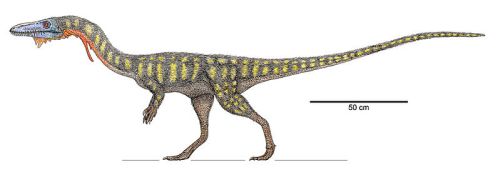
Coelophysis bauri (Cope, 1887)
Synonyms: Coelurus bauri Cope 1887; Rioarribasaurus colberti Hunt & Lucas 1991
Horizon: Chinle Formation, Arizona, New Mexico, and Utah (late Norian or Rhaetian (Lucas 1998), p.374)
Phylogeny: Podokesauridae : * (see Podokesaur phylogeny for differing hypotheses)
Size: length 2.5 to 3 meters, weight 15 to 30 kg (Paul 1988)
Comments: Very lightly built, long bodied, head long, weak bite, numerous small teeth, crests absent (Paul 2010 p.72). There are two morphs, indicating sexual differences.
This little animal is best known from the hundreds of specimens from the Ghost Ranch quarry in New Mexico, discovered, studied, described in detail, and popularised by Edward Colbert, who made it the archetypal primitive theropod. There's not much that can be said here that isn't already stated in the description of the group as a whole, see for example Podokesauridae characters (or see Wikipedia for a detailed non-technical coverage)
It was at one time believed that this animal practiced cannibalism (not uncommon among crocodilians), because some Ghost Ranch skeletons have juvenile-sized skeletons in the area of their stomachs, but thesewere later shown to to be misinterpreted (several specimens were actually small sphenosuchids such as Hesperosuchus, while in some cases it was simply that the remains of bigger individuals lay on top of smaller ones).
Cope's original type specimen of Coelurus bauri (= Coelophysis bauri) has turned out to be different species (now known to a Silesaurid protodinosaur) quite distinct from the Ghost Ranch species. This means that technically Coelophysis bauri could no longer be used for the latter. Paleontolgists Adrian Hunt and Spencer Lucas, who made this discovery, therefore coined a different name, Rioarribasaurus, for the Ghost Ranch quarry specimens. But because the name Coelophysis was so well known and had been used in most of the scientific literature, Co;lbert and coworkers petitioned the International Commission on Zoological Nomenclature (ICZN) to have the type specimen of Coelophysis transferred from the poorly-preserved original specimen to one of the well-preserved Ghost Ranch specimens. The unpronouncable Rioarribasaurus became a nomen rejectum, or "rejected name", and Coelophysis a nomen conservandum ("conserved name"). Cope's original specimen became Eucoelophysis baldwini Sullivan and Lucas, 1999. MAK120216
Image: Coelophysis by Jeff Martz, via Wikipedia
Coelophysis rhodesiensis (Raath, 1969)
Synonyms: Syntarsus rhodesiensis Raath, 1969, Megapnosaurus rhodesiensis (Raath, 1969)
Horizon: Upper Elliot Formation, Cape Province, South Africa; and Forest Sandstone of Matabeleland, Zimbabwe, (Hettangian/Sinemurian)
Phylogeny: Podokesauridae : * (see Podokesaur phylogeny for differing hypotheses)
Size: length 2 to 3 metres; weight 10 to 25 kg
Comments: A descendent of the Triassic Coelophysis bauri, this active little animal shows a number of more advanced features, such as a much larger "window" (the antorbital fenestra) in the front side of the snout, possibly for housing a gland of some kind, and teeth that are entirely forward of the eye. There is also the fusion of some of the upper foot-bones (metatarsals), a bird-like characteristic that would increase the strength of the leg. The behaviour appears to be the same as C. bauri, for the remains of large numbers of this species, in various ages, are found concentrated together in a single small quarry area. Like present-day birds, Syntarsus seems to have lived in large groups or flocks of individuals (the species is known from at least 30 partially articulated skeletons, juvenile to adult, found in one locality). (Paul 1988 p.262f.). Leg longer relative to the body than C. bauri (Paul 2010 p.73). A related form, known from fragmentary remains, has been found in the Early Jurassic Lufeng Formation (Yunnan Province, China) (Irmis2004), showing that these animals had a global distribution. As with C. bauri, head crests are absent.
Podokesaurs seem to have a particular problem with the names they are given. This particular animal's name has been much more of a controversy than Coelophysis/Rioarribasaurus (see above) ever was. The original name Syntarsus ("fused ankle", referring to the common podokesaurid condition of fused tibio-tarsal and fibula-tarsal bones) turned out to already have been given to a Colydiine beetle (in nomenclatural jargon we say the name was "preoccupied"). The entomologists who made this discovery instead coined the substitute generic name Megapnosaurus Ivie, Slipinski, and Wegrzynowicz, 2001. This was considered very bad form in the paleontological community, mostly because because taxonomists are expected to allow original authors of a name to correct any mistakes in their work, and the meaning of the new name ("big dead lizard") didn't help. Raath himself was aware of the homonymy and was planning to emend it, but the group who coined the new name had been unable to contact him, and came to the conclusion that he was deceased (see discussion on dinosaur mailing list archives beginning here and here). Raath later argued that the genus is a junior synonym of Coelophysis (a suggestion originally proposed by Greg Paul (1988)), as did Adam Yates (Yates 2005), and as a result, few palaeontologists accept the new name, although Megapnosaurus remains a valid name which must be used if a monotypic (one genus, one species) nomenclature is used. MAK120216
Coelophysis kayentakatae (Rowe, 1989)
Synonyms: Syntarsus kayentakatae Rowe, 1989, Megapnosaurus kayentakatae (Rowe, 1989)
Horizon: Kayenta Formation, Arizona (late Sinemurian or early Pliensbachian)
Phylogeny: Podokesauridae : * (see Podokesaur phylogeny for differing hypotheses)
Size: 2.5 meters, weigth about 30kg (Paul 2010 p.74)
Comments: Head fairly deep, more robust and teeth larger and less numerous than in other species, (Paul 2010 p.74). two small crests, similar to those of its larger cousin Dilophosaurus. As with other species of Coelophysis, it is represented by a number of specimens, indicative of social behaviour, in this case 16 individuals, juvenile to adult. MAK120217
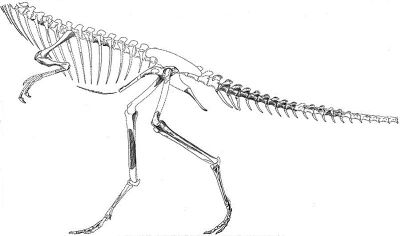
Segisaurus halli Camp, 1936
Horizon: Navajo Sandstone of Arizona (Toarcian)
Phylogeny: Neotheropoda : *
Size: length about 1.3 meters, weight 5 kg? (Paul 1988)
Comments: known only from a partial, headless skeleton, and previously placed in its own family, the Segisauridae, this is a small, very slender animal. It was originally thught that some of its limb bones were solid rather than hollow as they are in all other small theropods, but solid, but this turned out not to be the case, and Segisaurus is pretty typical in this regard. Also, for a long time it was unusual for being one of the few theropods for which a good clavicle was known. Its hip bones have unusual holes and flattening. According to Gregory Paul, it also possesses some advanced features. (Paul 1988). It is now considered a primitive podokesaur ((basal coelophysoid), perhaps related to Procompsognathus Carrano et al 2005. If that is the case then there were at least two lineages of small early theropods, podokesaurines and segisaurines (subfamily (new rank) Segisaurinae) MAK120216
Image: Restoration of Segisaurus halli holotype skeleton, from Camp 1936, via Wikipedia, public domain
Liliensternus liliensterni (von Huene, 1934)
Horizon: upper Keuper of Thuringia, Germany (late Norian)
Phylogeny: Neotheropoda : Podokesauridae + (Zupaysaurus + (Dilophosaurus + Averostra)) + *
Size: length 5.15 meters, weight 127 kg (Paul 1988)
Comments: Originally known as Halticosaurus; the specific and later generic name honours the German amateur paleontologist, Dr. Hugo Rühle von Lilienstern, who discovered the original fossils in the eraly 1920s. a poorly known form, consisting of disarticulated remains of at least two individuals, and fragmentary skull material. This was a lightly built animal, more like an oversized Coelophysis than a dilophosaur Greg Paul 2010) p.74) . Depending on who you ask, Liliensternus is either as a basal taxon of a monophyletic Coelophysidae (Ezcurra & Cuny 2007, Smith et al 2007, Xu et al 2009), or a derived/advanced taxon intermediate between coelophysids and dilophosaurs (Paul 1988 pp.267-8, Nesbitt et al 2009). Following Greg Paul (1988), this species is uniformly drawn with head crests, although it is not known if it actually had them. Lophostropheus (originally Lilensternus) airelensis, from the Rhaetian of France , known from partial remains, may be related, although it is different enough to deserve its own genus. About all that can be said of these poorly known animals is that they show that respectable sized theropods were around in the late Triassic. These animals were about the same length, but much lighter, then contemporary rauisuchian thecodonts; the two types of creature obviously filled very different ecological roles.
Links: material online is as scanty as knowledge of these species in general: Wikipedia, here as often elsewhere, the best coverage; Thescelosaurus! - short entry on this species and every other dinosaur taxon; Dinosaur mailing list - a few comments by Mickey Mortimer, the page is good overview of Triassic European theropods (and shows how scrappy this material is; in contrast to contemporary plateosaurs, known from excellent material)
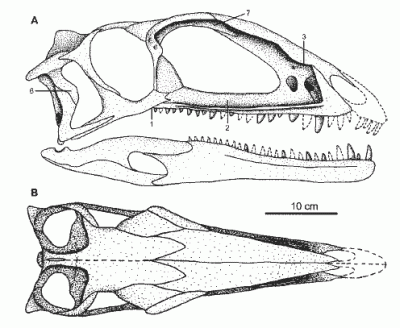
Zupaysaurus rougieri Arcucci and Coria, 2003
Horizon: Los Colorados of Argentina (?Rhaetian)
Phylogeny: Neotheropoda : Podokesauridae + Liliensternus ((Cryolophosaurus + Dilophosaurus + Dracovenator + Averostra) + *)
Size: Sull: 45 cm, Length: up to 4 meters (Wikipedia)
Comments: known from an almost complete skull and partial postcrania. Originally considered the earliest known and most basal tetanuran, supporting the original (now no longer supported) cladistic division of Ceratosauria and Tetanurae (which would have required Triassic tetanurans). Later studies placed it as a basal coelophysoidean (Carrano et al 2005), a member of a monophyletic Dilophosauridae Yates 2006, a non-coelophysid coelophysoid (Ezcurra & Novas 2007), or intermediate between coelophysids and dilophosaurs (Smith et al 2007; Nesbitt et al 2009, Xu et al 2009); the latter interpretation being the one we have followed here. The apparent Tetanurae synapomorphies (maxillary fenestra, caudally forked ascending ramus of the maxilla) are therefore better interpreted as homoplasies (convergence). (Ezcurra & Novas 2007). Zupaysaurus is distinguished by a moderately deep skull, large snout, and well developed paired crests (Paul 2010 p.75)
Links: Palaeocritti; Wikipedia, Thescelosaurus! (short entry) MAK120216
checked ATW030913, page last modified MAK120217